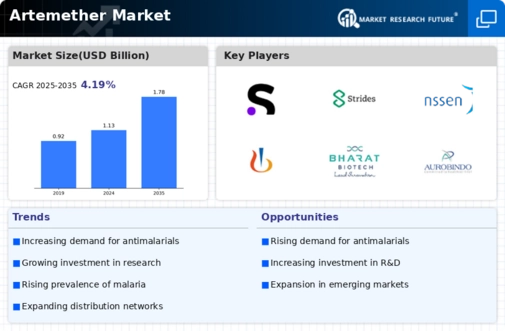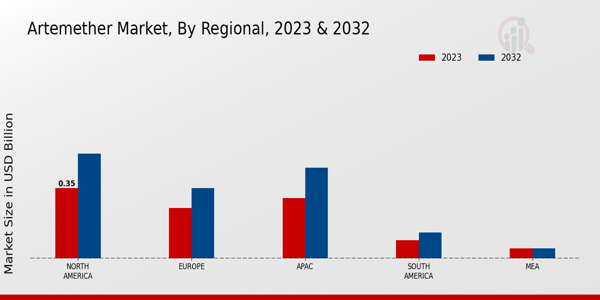Market Growth Projections
Increasing Malaria Incidence
The rising incidence of malaria globally is a primary driver for the Global Artemether Market Industry. According to the World Health Organization, malaria remains a significant public health challenge, particularly in sub-Saharan Africa. In 2024, the market is projected to reach 1.13 USD Billion, driven by the need for effective antimalarial treatments. Artemether, as a key component of artemisinin-based combination therapies, plays a crucial role in combating this disease. The increasing number of malaria cases necessitates the availability of Artemether, thereby propelling market growth. As malaria continues to affect millions, the demand for Artemether is likely to rise, contributing to the overall market expansion.
Government Initiatives and Funding
Government initiatives aimed at malaria control and prevention significantly influence the Global Artemether Market Industry. Many countries are implementing programs that focus on increasing access to effective treatments, including Artemether. For instance, various governments collaborate with international organizations to fund malaria treatment initiatives, which enhances the distribution of Artemether. This support is crucial, particularly in regions where malaria prevalence is high. The commitment to reducing malaria cases through funding and policy-making is expected to sustain market growth. As these initiatives continue to evolve, they may lead to a more robust demand for Artemether in the coming years.
Rising Awareness of Antimalarial Treatments
The growing awareness regarding the importance of antimalarial treatments is a significant factor driving the Global Artemether Market Industry. Public health campaigns and educational programs are increasingly informing populations about malaria prevention and treatment options. This heightened awareness is likely to lead to increased demand for Artemether, as individuals seek effective solutions for malaria management. Furthermore, healthcare providers are becoming more knowledgeable about the benefits of Artemether, which may enhance its prescription rates. As awareness continues to rise, the market for Artemether is expected to expand, potentially reaching 1.78 USD Billion by 2035, with a CAGR of 4.23% from 2025 to 2035.
Emerging Markets and Increased Accessibility
Emerging markets are becoming increasingly important for the Global Artemether Market Industry. Countries in Asia and Africa are experiencing economic growth, which is leading to improved healthcare infrastructure and increased access to medications. As these markets develop, the demand for Artemether is expected to rise, driven by a growing population and an increasing prevalence of malaria. Additionally, efforts to improve healthcare access in these regions are likely to facilitate the distribution of Artemether, making it more readily available to those in need. This trend suggests a promising future for the market, as emerging economies continue to prioritize health initiatives.
Technological Advancements in Drug Development
Technological advancements in drug development are shaping the Global Artemether Market Industry. Innovations in pharmaceutical research and development have led to the creation of more effective formulations and delivery methods for Artemether. These advancements not only improve the efficacy of the drug but also enhance patient compliance. For instance, new formulations may allow for easier administration, which is particularly beneficial in regions with limited healthcare access. As these technologies continue to evolve, they are likely to increase the attractiveness of Artemether as a treatment option, thereby driving market growth. The integration of technology in drug development may also lead to new partnerships and collaborations within the industry.













